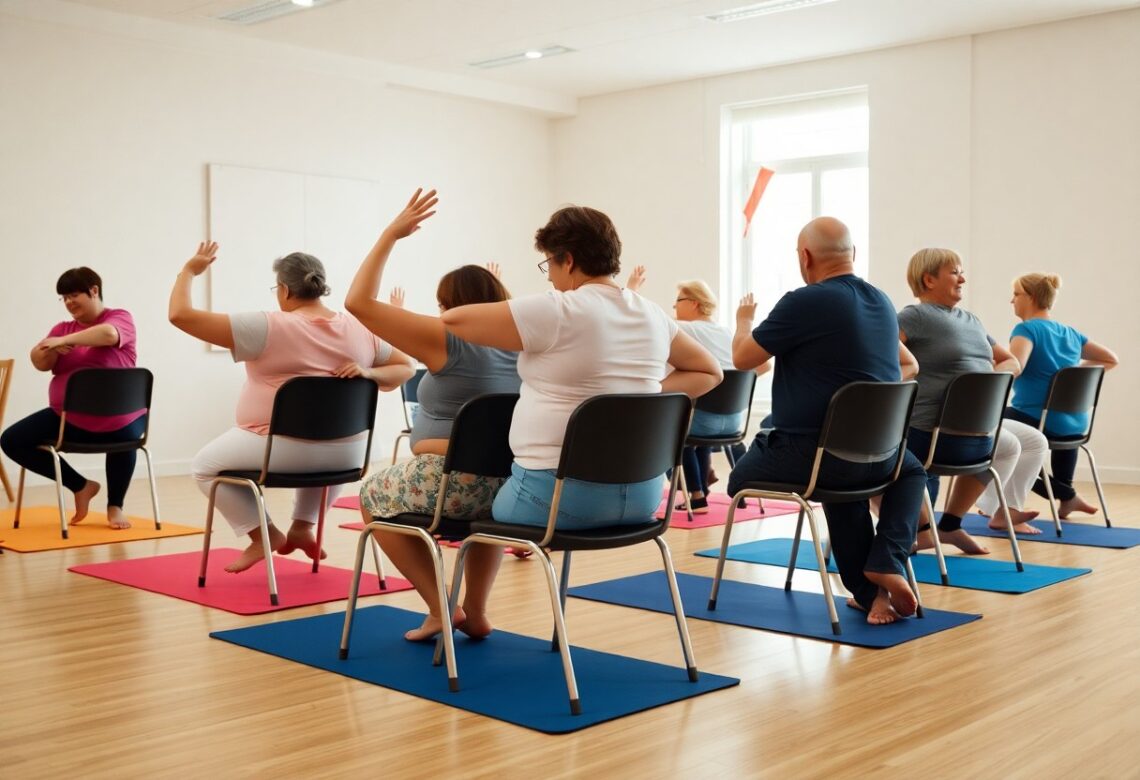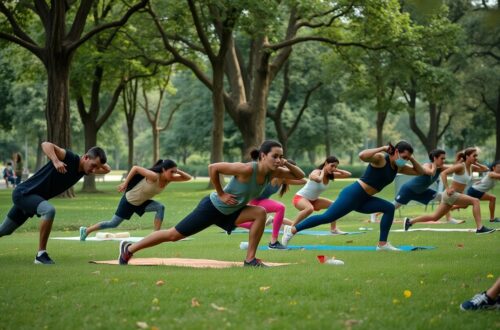Overcoming the barriers to physical activity can be challenging, especially for those who are overweight. However, integrating gentle chair exercises into your routine can significantly improve your strength, flexibility, and overall well-being without placing excessive strain on your body. These exercises are designed specifically for beginners, allowing you to make progress at your own pace while seated comfortably. By incorporating these movements into your day, you’ll gradually enhance your fitness levels and gain the confidence to explore further physical activities.
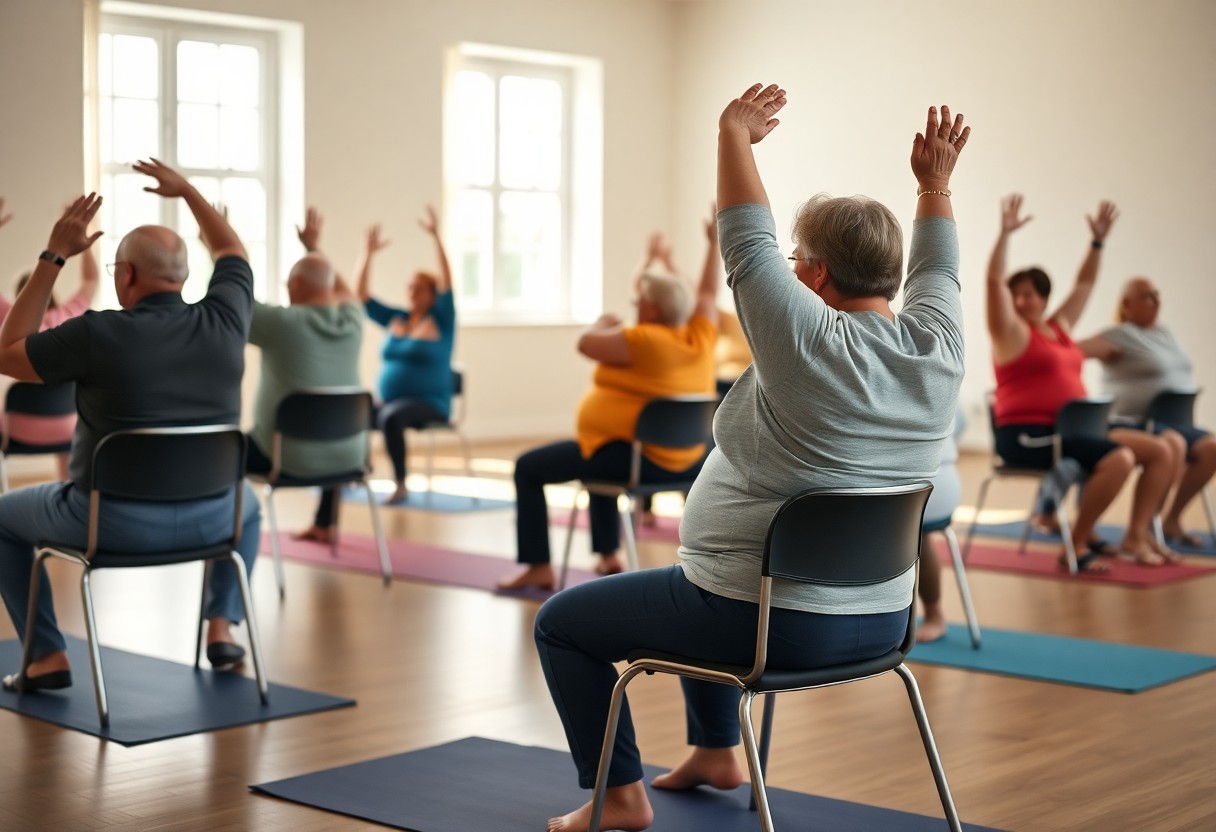
Key Takeaways:
- Accessible: Gentle chair exercises provide a low-impact option for overweight beginners.
- Improves Mobility: These exercises can enhance flexibility and increase overall mobility.
- Strength Building: Regular practice helps in building muscle strength without the strain of traditional workouts.
- Boosts Circulation: Engaging in chair exercises promotes better blood circulation and reduces the risk of stiffness.
- Convenient: They can be performed at home or in a community setting, making them easy to incorporate into daily routines.
- Social Interaction: Group chair exercise sessions can provide valuable social support and motivation.
- Mind-Body Connection: Focusing on breathing and movement enhances the mind-body connection, contributing to overall wellness.
Benefits of Chair Exercises
For overweight beginners, chair exercises offer an accessible way to increase physical activity without overwhelming your body. These gentle movements can help you improve flexibility, build strength, and enhance cardiovascular fitness while providing the support of a stable chair. Engaging in chair exercises can significantly boost your overall well-being and promote a healthier lifestyle, paving the way for more varied physical activities in the future.
Improved Mobility
The consistency of chair exercises can greatly enhance your overall mobility. By incorporating simple movements into your daily routine, you’ll gradually increase your range of motion, making everyday tasks feel easier. As you progress, you’ll find it easier to perform activities like walking or bending without discomfort.
Enhanced Strength
On your journey to fitness, chair exercises serve as an effective way to build strength in a controlled manner. Utilizing your body’s weight and resistance while seated allows you to engage various muscle groups, contributing to improved muscle tone and endurance.
Due to the low-impact nature of chair exercises, you can safely strengthen your muscles without the risk of injury that often accompanies traditional workouts. Focusing on functional movements helps develop the muscle strength needed for daily activities, such as standing up from a seat or climbing stairs. As you progressively increase your strength, you will establish a foundation for more challenging exercises in the future, contributing to your overall fitness journey and enhancing your quality of life.
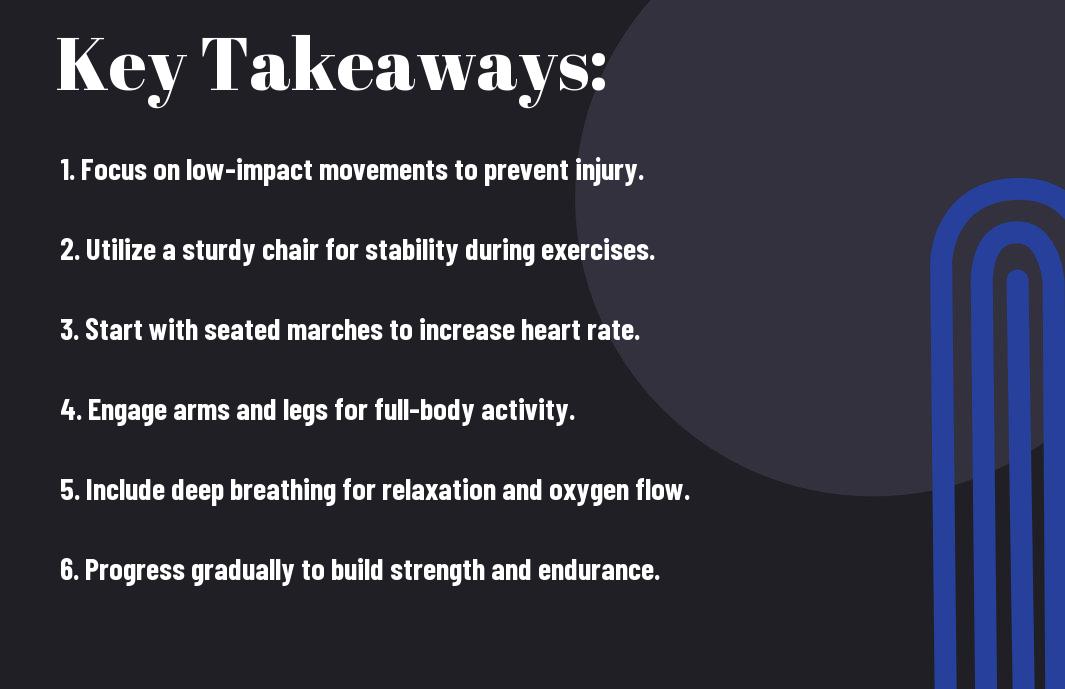
Safety Tips for Beginners
Assuming you are just starting your chair exercise journey, it’s vital to prioritize safety to prevent any injuries. Here are some important tips to keep in mind:
- Consult your doctor before beginning any new exercise routine.
- Ensure your chair is stable and has a solid back for support.
- Warm up before starting and cool down afterward.
- Use a resistance band for gentle modifications, if needed.
- Stay hydrated throughout your workout.
Any discomfort should be taken seriously; adjust or stop the exercise if necessary. For a great introduction to chair workouts, check out this Chair Workout for Seniors & Beginners // 15 minutes No ….
Proper Posture
After settling into your chair, focus on maintaining proper posture. Sit with your back straight and shoulders relaxed, avoiding slouching. Keep your feet flat on the floor and knees aligned with your hips. This alignment supports your body and enhances the benefits of your exercises.
Listening to Your Body
Along the way, pay attention to how your body feels during each exercise. It’s completely normal to feel some tension, but you should never experience sharp pain or extreme discomfort. Adjust your movements accordingly to ensure a safe and enjoyable experience.
In fact, your body provides valuable feedback during workouts. If an exercise feels too challenging or uncomfortable, modify it or choose a gentler option. You can also take breaks whenever needed to avoid overexertion. Trust your instincts, as respecting your body’s limits will help you build strength safely over time.
Essential Equipment
Once again, equipping yourself properly can enhance your chair exercises significantly. You don’t need a lot to get started, but having a sturdy chair is vital. For more suggestions, check out the 20 Best Chair Exercises For A Low-Impact, Full-Body … guide, which showcases effective movements to kickstart your fitness journey.
Choosing the Right Chair
About selecting the best chair, it’s important to find one that offers stability and comfort during your exercises. Look for a firm chair with armrests for support, ensuring it allows you to sit with your feet flat on the ground. A chair that is the correct height for your body can help prevent strain and make your workouts more enjoyable.
Optional Accessories
Below, you may want to consider some optional accessories to enhance your workout experience. Items such as resistance bands or light dumbbells can add variety and intensity to your chair exercises, allowing you to progress as you get stronger.
Chair exercises can be significantly enhanced with the right accessories. Resistance bands, for example, provide additional resistance to workouts without compromising balance, while light dumbbells can help you build strength in upper-body workouts. It’s important to choose weights that you can handle comfortably to prevent injury, ensuring you can focus on your form and technique.
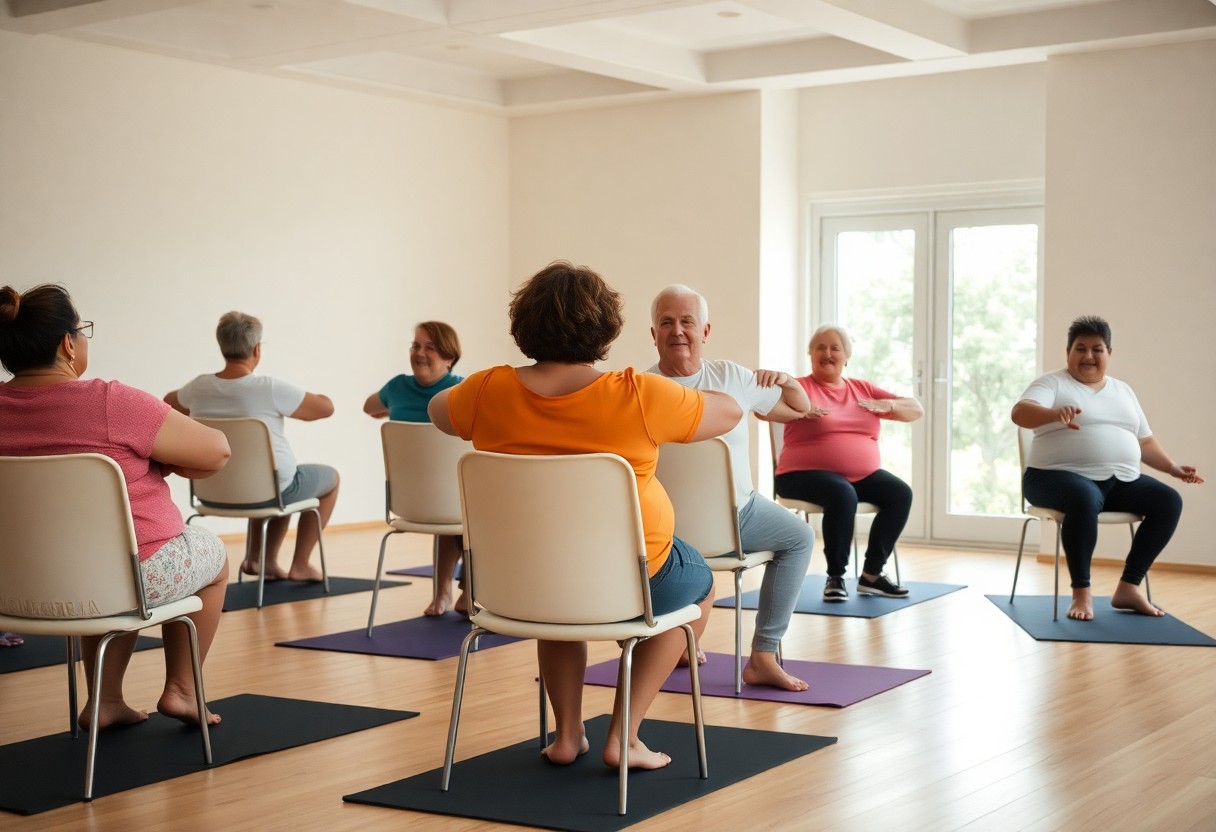
Gentle Chair Exercise Routine
Many individuals seeking to improve their fitness can benefit from a gentle chair exercise routine. These exercises are designed to provide a low-impact workout that elevates your heart rate while minimizing strain on your joints. You can perform them comfortably while seated, making them an excellent option for overweight beginners. This routine incorporates warm-up exercises, strength-building moves, and cool-down stretches to enhance your overall wellness.
Warm-Up Exercises
Along with getting your body ready for the workout, warm-up exercises help to increase circulation and flexibility. Simple movements like seated marches or gentle arm swings can prepare your muscles and joints for the activity ahead. Always take a few minutes to engage in these warm-up exercises to ensure a safe and enjoyable experience.
Strength Building Exercises
Chair exercises not only promote cardiovascular health but also help to build strength in your muscles. You can incorporate simple movements like seated leg lifts or arm curls using light weights, which will enhance your strength without overwhelming your body. These exercises can gradually be increased in intensity as you gain confidence and stability.
The key to success with strength-building chair exercises is consistency and progression. Start with a few repetitions and gradually increase as you feel stronger. Focus on your form and posture to maximize effectiveness and reduce the risk of injury. Building strength in a seated position provides stability, making it easier for you to incorporate a wider range of movements as you advance.
Cool Down Stretches
Down the road, it’s vital to include cool-down stretches to help your body recover after exercising. These stretches can alleviate tension in your muscles while gradually lowering your heart rate. Simple movements such as seated forward bends or gentle neck rolls can release any tightness and promote relaxation.
With regular cool-down stretches, you not only enhance your flexibility but also foster a sense of calm after your workout. Taking a few moments to breathe deeply and stretch helps your body transition back to a resting state. Incorporating these stretches into your routine will ensure you feel refreshed and ready for your next exercise session.
Modifications for Different Fitness Levels
Keep in mind that everyone is at a different fitness level, so it’s important to tailor chair exercises to suit your needs. You can find helpful resources on Exercise for obese people: Workouts for beginners. Modify movements by reducing the range of motion or using support to ensure you feel comfortable while exercising. By adapting these exercises, you can effectively improve your strength and balance at a pace that suits you best.
Beginner Variations
Beside standard chair exercises, you can incorporate beginner variations to ease into your routine. Consider performing seated marches or arm raises, which require minimal effort and can be adjusted based on your comfort. By focusing on gentle movements, you can build confidence as you develop your strength and flexibility, making your fitness journey more enjoyable.
Progression Techniques
On the path to increasing your fitness, progression techniques are important for growth. Start by gradually increasing the number of repetitions or duration of each exercise. Once you feel more stable with the basic movements, you can introduce small weights or resistance bands for added challenge. This way, you’ll steadily progress while ensuring your body adapts safely to increased demands.
At any stage of your fitness journey, it’s important to listen to your body and adjust your progression accordingly. By slowly incorporating new techniques and increasing exercise intensity, you can avoid injury and promote sustainable improvement. Keep challenging yourself at a manageable pace, and celebrate your achievements along the way, knowing that each small step brings you closer to your fitness goals.
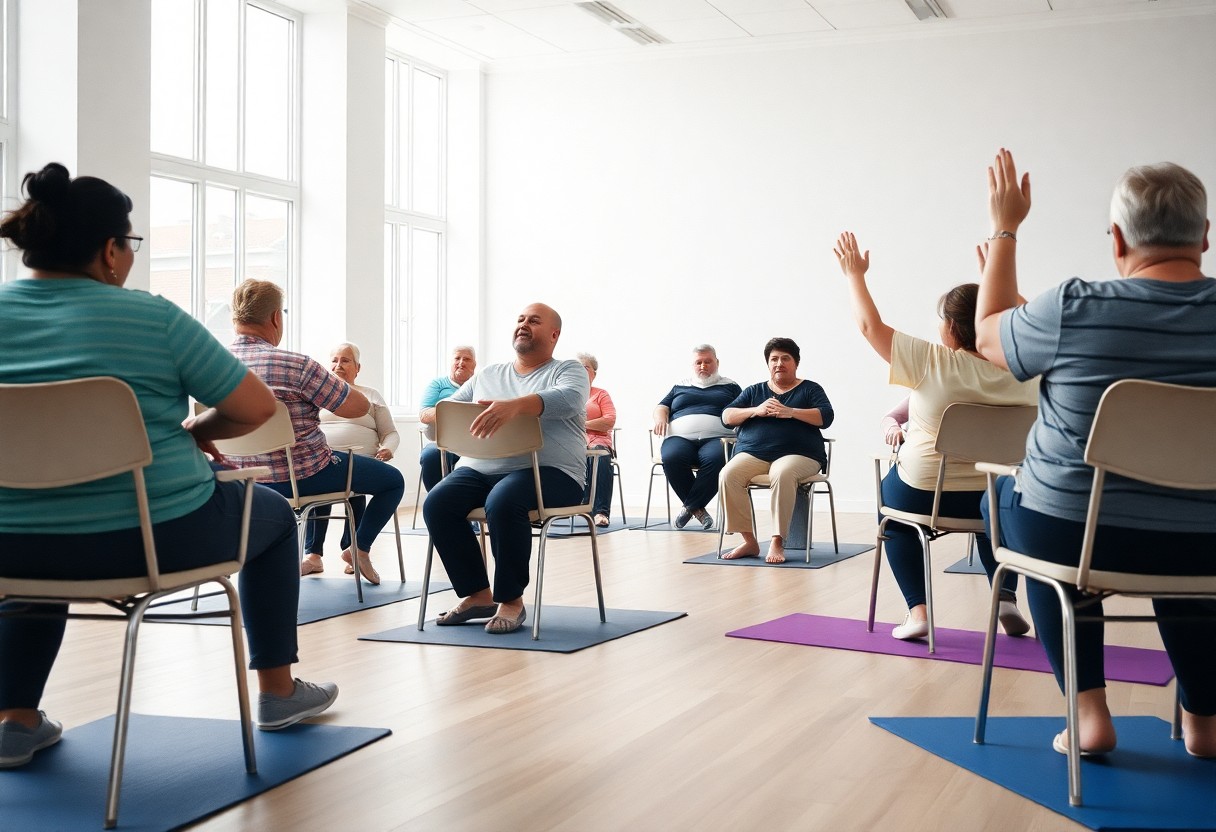
Creating a Consistent Exercise Schedule
Despite your busy life, establishing a consistent exercise schedule is necessary for your journey toward better health. Aim to set aside specific times each week dedicated to gentle chair exercises. Treat these appointments like any other commitment, allowing you to build a routine that fits your lifestyle. The more consistent you are, the easier it becomes to incorporate physical activity into your daily life, leading to long-term benefits.
Setting Realistic Goals
Schedule your goals with care, ensuring they are attainable and aligned with your current fitness level. Start by determining a frequency for your chair exercises that feels comfortable, such as two to three times a week. Celebrate small milestones along the way, allowing you to gradually increase your activity as your confidence and ability improve. By keeping your goals manageable, you will foster a sense of accomplishment and motivation.
Finding Accountability
Below are a few strategies to help you stay accountable in your exercise routine. Consider partnering with a friend or joining a group of like-minded individuals who share similar fitness goals. Regular check-ins or group sessions can provide motivation and encouragement. Additionally, you might find it helpful to track your progress using a journal or an app, helping you visualize your growth over time.
Realistic accountability is about creating a supportive environment that inspires you to stay on track. Engage with family and friends by sharing your goals, and don’t hesitate to ask them to join you in your chair exercise sessions. Building a community around your fitness journey can reinforce your commitment and make the process enjoyable. Accountability can be a powerful motivator that propels you toward your goals, ensuring you remain focused and engaged in your exercise routine.
To wrap up
To wrap up, incorporating gentle chair exercises into your routine can significantly enhance your fitness journey as an overweight beginner. These low-impact movements help improve your flexibility, strength, and overall well-being while minimizing the risk of injury. By dedicating just a few minutes each day to these exercises, you can gradually build your confidence, boost your energy levels, and pave the way for more advanced physical activities. Embrace this supportive approach to fitness and witness the positive changes in your body and mind.
FAQ
Q: What are gentle chair exercises, and who can benefit from them?
A: Gentle chair exercises are low-impact physical activities that can be performed while seated in a chair. These exercises are designed to improve flexibility, strength, and cardiovascular health without putting excessive strain on the body. Overweight beginners, seniors, and individuals with limited mobility can especially benefit from these exercises as they provide a safer way to stay active and engaged.
Q: How do chair exercises help overweight beginners?
A: Chair exercises offer a way for overweight beginners to gradually improve their fitness levels without the intimidation or difficulty of traditional workouts. They help enhance muscle strength, improve endurance, and promote joint mobility. Additionally, these exercises can support weight management and improve overall well-being by boosting mood and energy levels.
Q: What types of exercises are included in gentle chair exercise routines?
A: Gentle chair exercise routines typically include a variety of movements such as seated marches, leg lifts, arm raises, seated twists, and gentle stretches. These exercises can target different muscle groups and facilitate increased circulation, making them a well-rounded option for beginners looking to improve their physical activity.
Q: How often should overweight beginners perform chair exercises?
A: It’s advisable for overweight beginners to aim for about 2-3 sessions of chair exercises per week. Each session can last around 15-30 minutes, depending on individual comfort levels and progress. Gradually increasing frequency or duration as strength and confidence build can lead to better results over time.
Q: Is it necessary to consult a doctor before starting gentle chair exercises?
A: Consulting a healthcare professional before beginning any new exercise program is a good practice, especially for individuals with pre-existing health conditions or concerns. A doctor can provide personalized recommendations and help ensure that the chosen exercises are safe and appropriate for individual health circumstances.
Q: What equipment is needed for chair exercises?
A: One of the best aspects of chair exercises is that they require minimal equipment. A sturdy chair with a straight back is important. Optionally, beginners might also consider using light handheld weights, resistance bands, or exercise balls to introduce variety and further challenge their muscles as they progress.
Q: Can chair exercises be effective for weight loss?
A: While chair exercises alone may not lead to significant weight loss, they can certainly support weight management and overall fitness when combined with a balanced diet and other forms of physical activity. These exercises improve metabolism, promote muscle tone, and enhance overall physical capability, making it easier to engage in additional activities that support weight loss goals.
